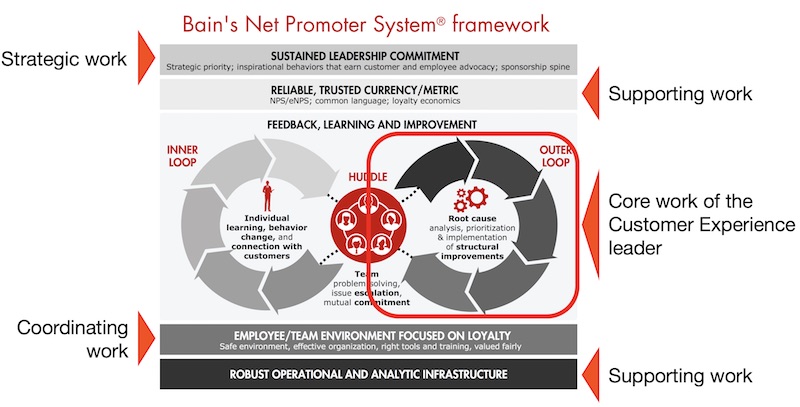Here is how to think about the work of the customer experience leader or Chief Customer Officer
I would like to propose a way of thinking about the work of the customer experience leader. It has four elements:
- Core work
- Supporting work
- Coordinating work
- Strategic work
Introduction
Here is a way of thinking about the work of the customer experience leader, whether they are called the Chief Customer Officer or something else. In large companies, the model should work well at division level, assuming divisions are largely independent of each other. I will use the Bain Net Promoter System Framework, shown at the top of this post, to structure the discussion. Each of the types of work is indicated with its name and an arrow. Some other improvement systems have similar components, so you should be able to apply these principles, no matter what system you use.
An exception that confirms the rule
Let me start by defining one type of work as being out of scope. Each individual business and function drives its own listening and improvement work. The customer experience leader generally does not get involved, with the exception of measurement systems, mentioned below. That is why I show the ‘Inner Loop’ in the framework diagram without an arrow.
Core work
The main work of the customer experience leader, the reason for his/her existence, should be to drive measurement and improvement work that crosses business and functional lines. These are things that no individual business or function can improve on their own. In Net Promoter System terms, this means running ‘Huddles’ that consider and work on items that cross organizational boundaries, and leading the ‘Outer Loop’ improvement work at company level.
Supporting work
This is work that has to be done well so the core work can happen. The most important supporting work areas are:
- Ensure that the measurement systems used are trusted and reliable. The entire company has to be able to understand the key metric or metrics, and believe that it/they do indeed correctly represent customer views of your company and of your competitors.
- Ensure that a reliable team and infrastructure exist to manage and correctly interpret customer input, and to drive improvements. The Net Promoter System, for example, depends on customer answers to open text questions. If your company gets a lot of these answers, you need software to analyse them reasonably accurately. If your customer research depends on sending people surveys by email, a single infrastructure for doing so should be your standard across the entire company. Without this, you will never be able to manage ‘opt out’ lists and other things that may be legal requirements in your country or countries.
Coordinating work
I believe training is the most important single piece of work that needs to be coordinated across an entire company. Teams should have a common understanding of the corporate position and tools for measuring and improving customer satisfaction. Letting each business and function do so on their own will confuse customers who deal with more than one part of the company.
Strategic work
This work is probably the hardest. The CEO and leadership team need to speak a common language and need to have customer improvement initiatives as part of their ‘Top 5’ formal objectives. The customer experience leader needs to have the diplomacy, empathy and organizational knowledge that will allow them to propose such initiatives and even to draft the initial documentation. It is unreasonable to expect that leaders with short-term objectives will spontaneously devote time to customer experience work that provides its benefits in the medium term. And I would put communication at the top of the strategic work list. This means both the communication work the customer experience leader does on his/her own and the content and platforms they provide to other leaders for them to use.
Conclusion
The fit between these four categories of work and the Net Promoter System Framework is reasonably good, even though it is not perfect. Excellence in the core work is what allows the customer experience leader to work on the other areas. I should note that this way of categorizing work was developed by Lawrence Megson as part of what he calls the ‘Fit Model’ methodology for organizational design. Lawrence worked at Digital Equipment Corporation (DEC) while I was there. While I have not used this structure in my books Customer Experience Strategy – Design and implementation, or Net Promoter – Implement the System
, it still helped me to think correctly about the work of CX leaders. As always, the fact that I have opinions does not make me right. Your views are welcome.
You can also email me, Maurice FitzGerald, at mfg@customerstrategy.net.




